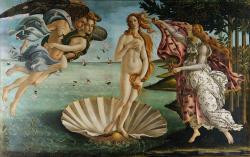<p>This third and final collection “The Portrayal of Powerful
Women In Visual Art: A Study Spanning Ancient Egypt, Baroque and Renaissance Periods, Through Impressionism, and Pop and Modern Art” has been building up since
the beginning of this project. I cannot stress enough how passionate I am about
representing women as strong and powerful beings and I think it is so important
to look back over history and find the times that was done despite attitudes
towards women. Women have always been viewed as the weaker
sex, until very recently in fact. However, the quiet and prevailing strength of
women has a thread that is woven back to the dawn of time. As I have stated in
a previous collection, visual art is an important way to document our
collective present so that future generations may have greater understanding of
our ways of thinking, values and more. My goal for these collections was to exemplify
the power that was evident in a woman over time and I feel that I have achieved
that. This collection spans time and cultures including ancient Egypt, the Renaissance
and Baroque periods, Impressionism, and pop and modern art. Influential, resilient,
and robust women always have and always will have a role to play in visual art.
</p>
<p>For my museum paper, I took a close look at impressionism,
especially Claude Monet (see the final tile in the collection). “Camille Monet
on a Garden Bench” by Claude Monet is an oil on canvas, impressionist painting
capturing Monet’s first wife, Camille, whom he painted often. Impressionism came to be in France in the
middle of the nineteenth century and Claude Monet is one of the names you immediately
associate with this style of painting. Monet is a household name in the realm
of impressionist painting and “Camille Monet on a Garden Bench” is just one of
the many famous works he produced in his lifetime. In this painting, her
expression is one of quiet defeat and her large, dark eyes seem exhausted as if
she is mentally somewhere else while her gaze is fixed directly on the viewer.
Her body is hunched over rather than up straight to greet her neighbor. The
viewer feels her sadness and I think that is in part because of the contrast in
the image. The rest of the painting is bright, sunny and filled with color,
things associated with happiness and lightness. Camille is clothed in a dark,
heavy looking dress seemingly under the shadow of a tree which I interpret as
the metaphorical cloud hanging over her with the sad news of her fathers
passing. Monet captures her strength and femininity all at once. </p>
<p>Pop and modern art seem much more literal in what it expresses and is an excellent reflection of society at that point in time. While
women still weren’t considered equal, they were still being depicted in visual
art and it was typically women of high standard and fame. These women were
respected in their fields and were considered icons of their generation; women
like Audrey Hepburn, Marilyn Monroe, Billie Holiday, Aretha Franklin, even Queen
Elizabeth II. Visual art and its representation of a woman’s place in society
still had a long way to go, but by looking at the women, we can tell they know
their strength and that is what’s most important. </p>
<p>What I have put together in this collection represents the
significance of women at points through history and I hope you will take
something away from it. I hope it will spark debate, deeper thought, an
emotional response, or even desire to learn more about the culture or time
period being represented. </p>
<p>#AHMC2019 </p>

Dana Cox
19
 Dana Cox
Dana Cox
 Dana Cox
Dana Cox
 Dana Cox
Dana Cox



